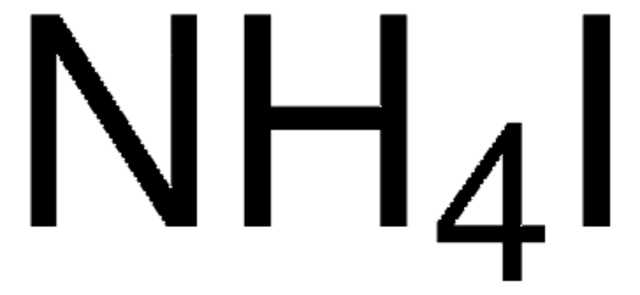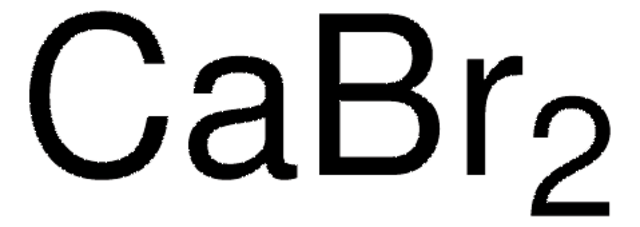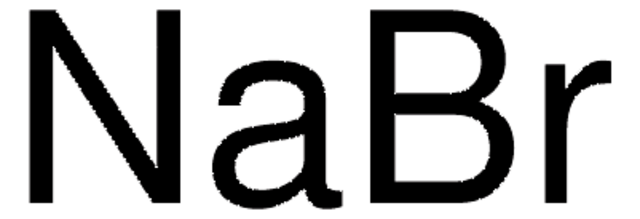Kluczowe dokumenty
467731
Ammonium bromide
≥99.99% trace metals basis
About This Item
diethyl ether: slightly soluble(lit.)
ethanol: soluble(lit.)
Polecane produkty
ciśnienie pary
1 mmHg ( 198.3 °C)
Próba
≥99.99% trace metals basis
Formularz
powder and chunks
zanieczyszczenia
≤0.005% insolubles
<100 ppm total metallic impurities
pozostałość po prażeniu
≤0.01%
pH
4.5-6.0
bp
396 °C/1 atm (lit.)
mp
452 °C (lit.)
rozpuszczalność
acetone: soluble(lit.)
diethyl ether: slightly soluble(lit.)
ethanol: soluble(lit.)
gęstość
2.43 g/mL at 25 °C (lit.)
ślady anionów
bromate (BrO3-): ≤0.002%
chloride (Cl-): ≤0.2%
iodide (I-): ≤0.005%
sulfate (SO42-): ≤0.005%
ślady kationów
Ba: ≤0.002%
Fe: ≤5 ppm
heavy metals: ≤5 ppm
ciąg SMILES
N.Br[H]
InChI
1S/BrH.H3N/h1H;1H3
Klucz InChI
SWLVFNYSXGMGBS-UHFFFAOYSA-N
Szukasz podobnych produktów? Odwiedź Przewodnik dotyczący porównywania produktów
Hasło ostrzegawcze
Danger
Zwroty wskazujące rodzaj zagrożenia
Zwroty wskazujące środki ostrożności
Klasyfikacja zagrożeń
Eye Irrit. 2 - Lact. - Repr. 1B - STOT RE 1 - STOT SE 3
Organy docelowe
Central nervous system, Nervous system
Kod klasy składowania
6.1C - Combustible acute toxic Cat.3 / toxic compounds or compounds which causing chronic effects
Klasa zagrożenia wodnego (WGK)
WGK 1
Temperatura zapłonu (°F)
Not applicable
Temperatura zapłonu (°C)
Not applicable
Środki ochrony indywidualnej
Eyeshields, Gloves, type N95 (US)
Wybierz jedną z najnowszych wersji:
Certyfikaty analizy (CoA)
Nie widzisz odpowiedniej wersji?
Jeśli potrzebujesz konkretnej wersji, możesz wyszukać konkretny certyfikat według numeru partii lub serii.
Masz już ten produkt?
Dokumenty związane z niedawno zakupionymi produktami zostały zamieszczone w Bibliotece dokumentów.
Nasz zespół naukowców ma doświadczenie we wszystkich obszarach badań, w tym w naukach przyrodniczych, materiałoznawstwie, syntezie chemicznej, chromatografii, analityce i wielu innych dziedzinach.
Skontaktuj się z zespołem ds. pomocy technicznej









